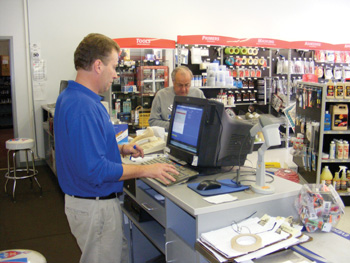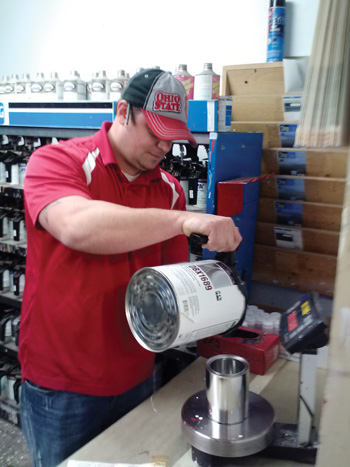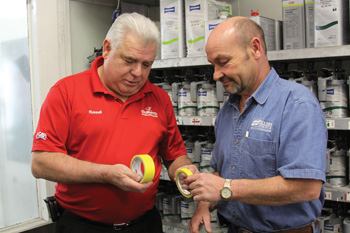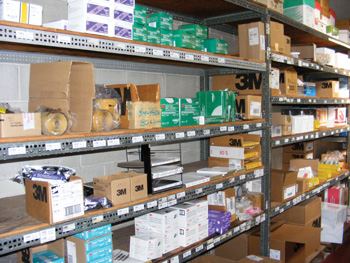 So I don’t sound like a broken record, I’ll keep my comments on the state of the industry to a minimum. However, it’s necessary to consider what’s currently going on in the industry to understand that the jobber and the shop owner are in the same boat.
So I don’t sound like a broken record, I’ll keep my comments on the state of the industry to a minimum. However, it’s necessary to consider what’s currently going on in the industry to understand that the jobber and the shop owner are in the same boat.
Shops no longer control their labor and material rates if they choose to do work for insurance companies. Parts prices have been pre-determined for years and are being cut into more deeply every day. Many insurers don’t allow mark-up on sublet, so the only thing left to make good gross profit on is paint and materials. But, with material rates being scrutinized more every day and some insurers imposing material thresholds, even that profit center is being squeezed.
Seek a Better Price
There are three ways, however, to increase your paint and material profit – and your jobber is key no matter which one you choose.
The most common way is to seek a better price. It has become standard practice for some shop owners to seek a new paint company every three to five years in order to take advantage of the money that’s available for switching brands. With this comes a new contract and purchase requirement that’s nothing more than a prepaid discount, which translates to a better price. The downside for the jobber is the fact that they most likely participate in the contract money, so their profit is greatly reduced until near the end of the agreement. About the time they begin to make a little return on their investment, they lose the business. The downside for the shop owner is the constant disruption in their business caused by changing product, retraining technicians and rewriting standard operating procedures (SOPs).
Since the rate is fixed, how do you gain margin between sales price and cost if you can’t reduce cost? The truth is you can’t – and that’s why the best method for reducing cost is to allow your jobber to sell you less. You might ask yourself, “Why would my jobber want to sell me less?” Well, ask yourself this: Would you be just as successful if you could repair 20 percent fewer cars but made 30 percent more profit on each vehicle? The obvious answer is yes, and this is possible if you become selective about the cars you repair.
It’s the same for a jobber. There are some product lines that a jobber makes a better gross profit on than others. While you may be an expert on repairing vehicles because you’ve repaired hundreds of them and have been formally trained, your jobber has sold product to and received feedback from hundreds of shops and has most likely been trained on the products they sell. Tell your jobber what you need the product to do, then let them select the product based on the best price and what they make the best profit on.
I can’t tell you how many times I’ve seen technicians, when the selection of the product was left up to them, select a name brand when the exact same product packaged under a generic name could have been purchased at a much better price. The only difference was the cost and who warrantied the product (the manufacturer or the jobber). Sometimes using a less expensive product may not be as cost effective because it doesn’t cover as well or go as far. A good jobber will take this into consideration.
 Use Less Product
Use Less Product
The second thing you can do to increase your paint and material profit is use less product. While it’s true that the job requires what it requires, the key is to eliminate the waste. There are multiple things the jobber can do to accomplish this goal.
Most paint formulation software today has the capability of tracking what’s weighed across the scales. More than once, I’ve had a shop owner tell me that they didn’t want their technicians to be bothered with any additional tasks such as entering customer information because of the loss time. But look at what happens in an emergency room at a hospital. The ER personnel are dealing with life-and-death situations and still manage to get the information they need to perform their jobs properly. Each time I’ve seen shop owners enforce material tracking, usage improved.
Another thing that a jobber can do is report usage based on your sales. Looking at what other customers purchase, they may be able to give you benchmarks as to what your range should be. The jobber I work for can give you a purchasing report that flags usage of products and whether it has trended up or down in relation to other products purchased.
Another way to use less product is to use the right one for the job. For example, most anything that can be masked with 2-inch masking tape can be masked with 1 1/2-inch tape, and the 1 1/2-inch tape is 30 to 40 percent less expensive than the 2-inch tape. The same holds true with 18-inch masking paper and 12-inch paper. While many shop owners often complain about the price of these products, jobbers will tell you that someone continues to order them every day. At one point, we had a pallet of 12-inch masking paper in our warehouse, and when I did a sales search, I discovered that we only had one customer buying it.
Masking products are only one example; there are many others like mixing cups, cans and clearcoats. If you use disposable cups for mixing, spraying and storage, you can eliminate cans, mixing cups and a lot of clean-up thinner. Many shops are using disposable cups, but are still buying the other products as well. This is where your jobber might be able to provide some training. While less expensive clears might not be suitable on some vehicles, you might still consider using them on jambs and high-mileage vehicles.
 Increase Sales
Increase Sales
The final thing you can try to increase the margin between cost and sales is to increase sales. You might say that estimating software and allowed material rates dictate sales, but if there was ever an opportunity to add sales through paint and materials, it’s today.
As technology has changed in new vehicles, we’ve failed to keep up on the material side of the equation. For example, think of the various materials used in replacing the average outer door panel. You may need panel bond adhesive; seam sealer; intrusion beam absorber adhesive; sound dampening material; peel rivets for the window regulator; chip coating; flex additive for trim; trim adhesive; weather strip adhesive; and door trim clips. Every one of these products has a part number and may need to be added as a line item on the final bill. In many cases, the insurer will pay for these items if you have a method of tracking and invoicing them. This is where the jobber comes into the picture.
 Most jobbers have access to some method of tracking these types of products. Every jobber will have current pricing on these products, and should be able to help you document and invoice them. There are many ways to do this.
Most jobbers have access to some method of tracking these types of products. Every jobber will have current pricing on these products, and should be able to help you document and invoice them. There are many ways to do this.
You may have an internal method of tracking and invoicing these consumables, and only need the jobber to keep pricing updated and provide a purchasing report to identify what products you or your technicians are ordering. Another method might be to establish what items you purchase that you may choose to re-sell as a consumable item or as a part. When an order is placed for one of these items, it may be treated a little differently. You may want to provide the jobber with a purchase order that includes a repair order number. When the order is filled, you can require that the jobber put the repair order number on the invoice. You might also include the service representative’s or estimator’s name and ask that a copy of the invoice be given to them so it can be filed and added to the bill.
Because jobbers work with multiple shops that are all struggling with the same issues, they often work with consultants who may offer assistance and training on increasing sales. They may also work closely with materials management software, or some type of cooperative that offers rebates on purchases.
Find the Right Jobber
Whether you decide to try to increase paint and material margins by cutting cost, cutting usage or selling more product, your jobber can be a huge asset to you. Most will gladly go out of their way for a loyal customer.
As a former technician, shop manager and owner who has worked for a jobber for the last seven years, I strongly recommend sitting down with your jobber and asking for their help with material management. Here’s the bottom line: If you want to be above average on paint and materials profitability, you need to find and partner with an above-average jobber. If you find the right jobber, they’ll deliver more than a can of paint.
Tony Nethery is the business development manager at COLORMATCH. He’s an I-CAR instructor and has worked in the collision industry for more than 30 years. He can be reached at (731) 267-5627 or [email protected].













